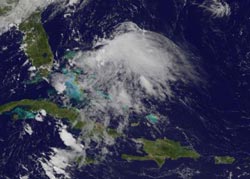Satellite views Chantal's remnants over Bahamas

This visible image from NOAA's GOES-13 satellite shows the remnant clouds and showers from Chantal over the Bahamas and the adjacent Atlantic waters at 9:45 a.m. EDT on July 12, 2013.<br><br>Credit: NASA GOES Project<br>
A visible image from NOAA's GOES-13 satellite at 9:45 a.m. EDT on July 12, 2013 showed Chantal's remnant clouds and showers moving north in the Atlantic.
The image of Chantal's remnants resembled the sideways view of a jellyfish. The GOES image was created by NASA's GOES Project at the NASA Goddard Space Flight Center, Greenbelt, Md.
The National Hurricane Center (NHC) noted that the remnants remain disorganized, and that development has become less likely. Upper-level winds helped cause the demise of the tropical cyclone and continue to affect the storm.
On July 13 at 8 a.m. EDT, the NHC gave Chantal's remnants a 10 percent change of regenerating into a tropical cyclone during the next 48 hours. In fact, the NHC even canceled the Air Force reconnaissance mission scheduled for July 13.
Media Contact
More Information:
http://www.nasa.govAll latest news from the category: Earth Sciences
Earth Sciences (also referred to as Geosciences), which deals with basic issues surrounding our planet, plays a vital role in the area of energy and raw materials supply.
Earth Sciences comprises subjects such as geology, geography, geological informatics, paleontology, mineralogy, petrography, crystallography, geophysics, geodesy, glaciology, cartography, photogrammetry, meteorology and seismology, early-warning systems, earthquake research and polar research.
Newest articles

“Nanostitches” enable lighter and tougher composite materials
In research that may lead to next-generation airplanes and spacecraft, MIT engineers used carbon nanotubes to prevent cracking in multilayered composites. To save on fuel and reduce aircraft emissions, engineers…

Trash to treasure
Researchers turn metal waste into catalyst for hydrogen. Scientists have found a way to transform metal waste into a highly efficient catalyst to make hydrogen from water, a discovery that…

Real-time detection of infectious disease viruses
… by searching for molecular fingerprinting. A research team consisting of Professor Kyoung-Duck Park and Taeyoung Moon and Huitae Joo, PhD candidates, from the Department of Physics at Pohang University…




















